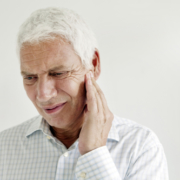How Upper Neck Misalignments Are Related To TMJ Dysfunction
The temporomandibular joints, TMJ, are the lower jaw hinges that sit on either side of the head in front of each ear. They are responsible for the lower jaw opening, closing, sliding, and rotating. The TMJs are the most body’s most complex joints. The typical person uses them more than 5,000 times a day by talking, laughing, yawning, chewing, eating, smiling, and swallowing.
What is TMJ Dysfunction?
TMJ dysfunction occurs when one or both joints become inflamed or injured causing pain and immobility in the jaw area. Because these joints are used so often and tend to be far more mobile than most other joints in the body, they can be prone to pain.
It is important that both joints work together because if they don’t it could result in more pressure on one joint than the other and this could cause the pain and discomfort that is associated with TMJ dysfunction.
What are the symptoms of TMJ Dysfunction?
There are many symptoms of TMJ dysfunction and they may vary depending on the patient, the extent of inflammation or injury, and the cause of the dysfunction. The symptoms may appear suddenly when there is injury to the joint, or they can gradually develop over a period of months or even years. They may be mild and barely noticeable or they can be severe and debilitating. The most common symptoms of TMJ dysfunction include:
- Jaw pain
- Jaw pain when moving the joint such as chewing or talking
- Popping or clicking of the joint
- Pain in the face or side of the neck
- Locking jaw
- Headaches
- Toothache
- Earache
- Clogged or “stopped up” ear
- Ringing in the ears (tinnitus)
TMJ dysfunction can significantly impact a person’s quality of life because the pain prevents them from doing many things they normally do, and often the jaw itself simply no longer functions as it should.
What causes TMJ Dysfunction?
Damage to the joint is the primary cause of pain associated with TMJ dysfunction. This can be the result of trauma such as:
- Dental work
- Sports injury
- Getting punched or hit
- Car accident
- Slip and fall accident
Subtle movements done repetitively can also cause TMJ dysfunction:
- Grinding teeth
- Holding a phone between the head and shoulder
- Clenching teeth
- Nail biting
- Gum chewing (excessive)
- Eating hard or tough foods
How can upper neck misalignment cause TMJ dysfunction?
When the upper neck sustains trauma such as whiplash it can cause a misalignment. This can also cause TMJ dysfunction in a couple of ways. It can cause one side to work harder or sustain more pressure than the other, or it can put excess pressure on the trigeminal nerve. This causes irritation and inflammation.
When left untreated, the condition can become severe. The misalignment keeps the joints from working as they should because opening and closing the jaw pinches the disc. This results in painful spasms in the shoulder and neck muscles when the patient does simple, everyday activities like talking, smiling, eating, or laughing.
Chiropractic for TMJ dysfunction
Chiropractic can be a very effective treatment for TMJ dysfunction, especially if it is due to neck misalignment. A chiropractor will perform spinal adjustments in order to realign the spine and neck, bringing the body back into balance. This will allow the jaw to work as it should, minimizing rubbing or friction in the joint.
The patient may also be told to apply heat, massage, and do special exercises for TMJ dysfunction that will help the joints heal and help to minimize the pain.
TMJ dysfunction is not always easy to diagnose so it is wise to talk to your chiropractor and get a diagnosis before attempting any treatment or home remedies for TMJ. Regular chiropractic treatment can not only relieve the pain of TMJ and help to heal it, it can also help prevent it. Your chiropractor can be a great ally in this endeavor.
Call (780)455-2112 to schedule your chiropractic assessment today! Visit www.ocwc.ca to learn more about our doctors.


